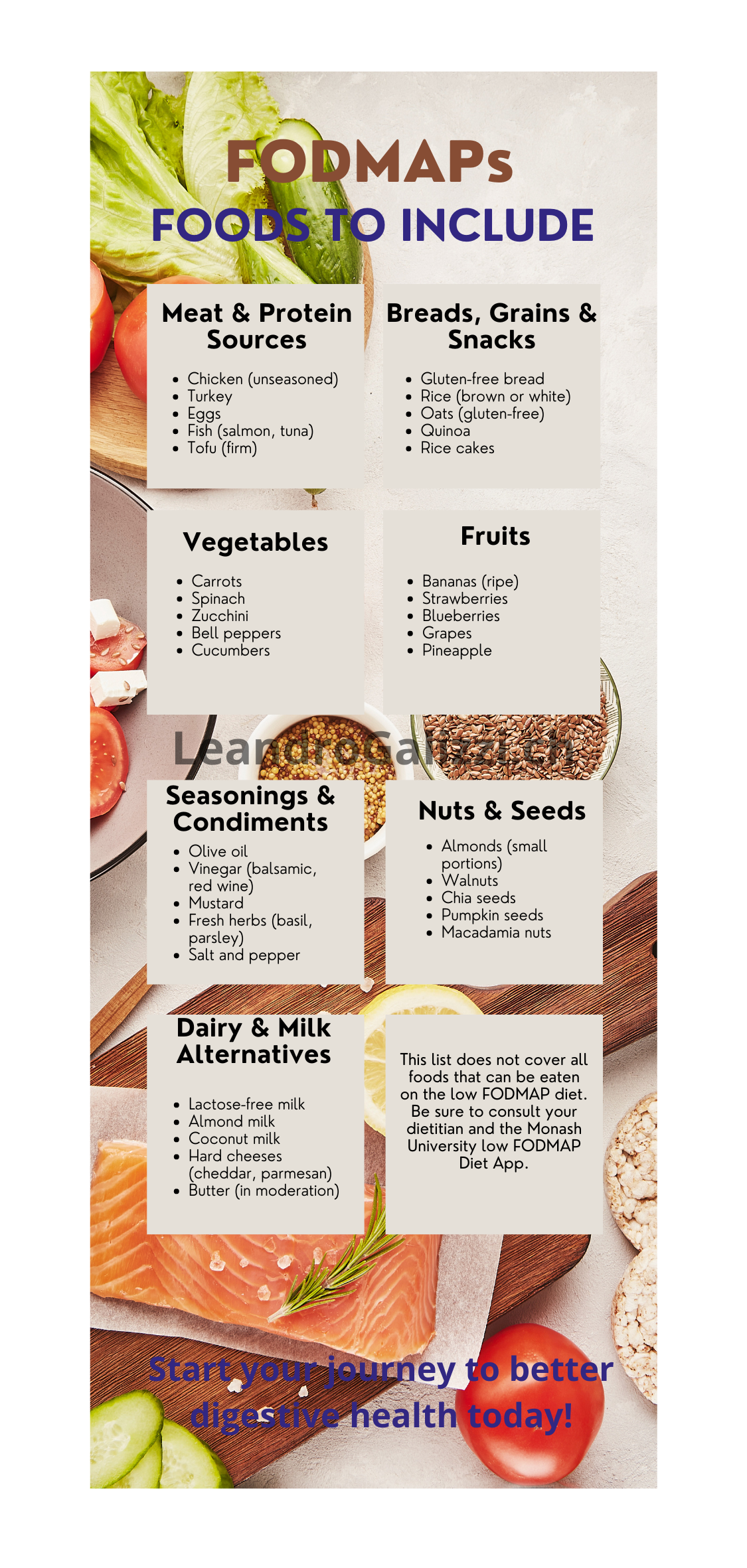Low-FODMAP Diet for IBS Relief: A Complete Guide

- Introduction
- What is the Low-FODMAP Diet?
- How the Low-FODMAP Diet Works
- Benefits of the Low-FODMAP Diet
- Practical Tips for Following a Low-FODMAP Diet in Switzerland
- Challenges of the Low-FODMAP Diet
- Conclusion
Introduction
Living with Irritable Bowel Syndrome (IBS) can be challenging, especially when digestive discomforts like bloating, abdominal pain, and irregular bowel movements become a regular part of life. Fortunately, the Low-FODMAP diet for IBS relief has proven to be an effective solution, helping many reduce their symptoms and regain control of their digestive health.
One of the most promising methods to alleviate IBS symptoms is through dietary changes. Research shows that the food we eat plays a significant role in either aggravating or easing IBS. Among the most effective diets for managing IBS is the Low-FODMAP diet, an evidence-based approach that has helped many people reduce their digestive discomfort.
If you’ve been struggling with IBS, you may have already heard of the Low-FODMAP diet. But is it the right solution for you? Let’s explore what this diet entails and how it can help you take control of your digestive health.
What is the Low-FODMAP Diet?
The Low-FODMAP diet is a specialized eating plan designed to help those with IBS manage their symptoms. But what exactly are FODMAPs? FODMAP stands for Fermentable Oligosaccharides, Disaccharides, Monosaccharides, and Polyols—which are types of carbohydrates that can be poorly absorbed in the gut.
In simple terms, FODMAPs are found in a variety of common foods like wheat, garlic, onions, certain fruits, and dairy products. For people with IBS, these foods can trigger digestive symptoms such as bloating, gas, diarrhea, and constipation. This happens because FODMAPs are fermented by bacteria in the large intestine, leading to excess gas and water in the bowel, which can cause discomfort.
The concept of the Low-FODMAP diet was first developed by researchers at Monash University in Australia. Their studies have shown that reducing the intake of FODMAP-rich foods can significantly improve IBS symptoms for many people, helping them regain control over their digestive health.
While not everyone with IBS is sensitive to all types of FODMAPs, this diet offers a structured way to identify and avoid the specific triggers that cause discomfort, leading to a more personalized and sustainable approach to managing IBS.
How the Low-FODMAP Diet Works
The Low-FODMAP diet is typically divided into three key phases: Elimination, Reintroduction, and Personalization. Each phase helps you gradually discover which FODMAPs are problematic for your body.
1. Elimination Phase
During this phase, you’ll avoid all high-FODMAP foods for a period of 4 to 8 weeks. This allows your digestive system to reset and gives your body a break from the potentially irritating effects of FODMAPs. It’s important to follow this phase under the guidance of a healthcare provider or dietitian to ensure you’re still receiving all necessary nutrients.
2. Reintroduction Phase
After the elimination phase, you’ll start slowly reintroducing FODMAP-rich foods one at a time. This helps you identify which specific foods trigger your IBS symptoms. For example, some individuals may find that lactose is a problem, while others may react to fructose-rich foods Each food is reintroduced over the course of several days to monitor any reactions before moving on to the next food.
3. Personalization Phase
Once you’ve identified the FODMAPs that trigger your symptoms, the final step is to create a customized, long-term eating plan. You’ll avoid or limit only the foods that cause problems, allowing you to enjoy everything else without worry. This phase ensures that you can still maintain a varied and nutritious diet while keeping IBS symptoms under control.
This three-step process allows for a personalized approach to managing IBS, making it easier to stick with the diet and avoid unnecessary restrictions.
Benefits of the Low-FODMAP Diet
The Low-FODMAP diet has gained popularity not just because it’s effective, but because it offers a wide range of benefits for people with IBS. Numerous studies have shown that up to 75% of IBS sufferers experience significant symptom relief after following the Low-FODMAP diet. Here are some of the key benefits:
- Reduced Digestive Symptoms: Many people report fewer episodes of bloating, gas, diarrhea, and constipation when following a Low-FODMAP diet. This can make everyday activities more manageable and less stressful.
- Improved Quality of Life: With fewer digestive issues, individuals often feel more comfortable engaging in social events, traveling, and eating out without fear of a sudden IBS flare-up.
- Better Digestive Health: By identifying and eliminating trigger foods, you can prevent ongoing inflammation and irritation in the gut, promoting overall digestive healt.
Overall, the Low-FODMAP diet provides a structured and evidence-based approach to improving digestive health and managing IBS, which can have a significant positive impact on daily life and well-being.

Practical Tips for Following a Low-FODMAP Diet in Switzerland
Adopting a Low-FODMAP diet can feel overwhelming at first, especially when living abroad, where navigating local grocery stores, dining out, and social gatherings may present additional challenges. However, with a little planning and the right resources, it can be manageable. Here are some practical tips to help you stay on track:
1. Shopping for Low-FODMAP Foods
When shopping, you’ll find that many low-FODMAP ingredients are available in local supermarkets and health food stores. Look for gluten-free alternatives to bread and pasta, as wheat-based products are high in FODMAPs. Dairy alternatives like almond or lactose-free milk are also easy to find. Additionally, fresh fruits like bananas, oranges, and blueberries, and vegetables such as carrots, spinach, and cucumbers, are all low-FODMAP and widely available.
2. Eating Out in Restaurants
Dining out while following a Low-FODMAP diet can be tricky, but it’s not impossible. Opt for dishes that are naturally low in FODMAPs, such as grilled meats or fish with plain vegetables. Avoid sauces, dressings, or dishes that may contain hidden high-FODMAP ingredients like onions or garlic. Don’t hesitate to ask the restaurant staff about the ingredients or request modifications to suit your dietary needs.
3. Navigating Social Gatherings
Social gatherings can be another challenge, but there are strategies to handle them. Bringing a low-FODMAP dish to share ensures you have something safe to eat. If you’re attending a meal where the host may not be familiar with your dietary needs, consider explaining the basics of the diet ahead of time or offering to help plan the menu.
4. Using Helpful Resources
There are several resources that can help you stick to the Low-FODMAP diet more easily. The Monash University Low-FODMAP Diet App is an excellent tool for checking the FODMAP content of various foods and getting recipe ideas. Additionally, working with a dietitian who understands the Low-FODMAP diet is crucial to ensure you’re meeting your nutritional needs.
Challenges of the Low-FODMAP Diet
While the Low-FODMAP diet can be highly beneficial for managing IBS symptoms, it does come with challenges. One of the biggest hurdles is ensuring you get enough nutrients while eliminating certain food groups. For example, avoiding dairy products can lead to a deficiency in calcium, and cutting out high-FODMAP vegetables may reduce your intake of magnesium.
It’s also important to avoid staying in the elimination phase for too long. Some people may be hesitant to reintroduce foods after experiencing relief, but this can lead to overly restrictive eating and potential nutrient deficiencies. Over time, cutting out too many FODMAP-rich foods may also affect your gut microbiome, reducing the diversity of healthy bacteria that support digestion.
This is why it’s vital to work closely with a healthcare provider or dietitian throughout the process to ensure you’re following the diet safely and effectively.
Conclusion
The Low-FODMAP diet offers a proven and structured way to manage IBS symptoms and improve your quality of life. By identifying and eliminating the foods that trigger digestive discomfort, you can take control of your gut health and feel more confident in your daily activities.
If you’re struggling with IBS and have yet to find relief, the Low-FODMAP diet could be the solution you’ve been searching for. However, remember that this diet should be followed under the guidance of a healthcare professional to ensure it’s done safely and to avoid long-term nutrient deficiencies. Are you ready to take the first step toward mastering your IBS symptoms?
References
1. Halmos, E. P., Power, V. A., Shepherd, S. J., Gibson, P. R., & Muir, J. G. (2014). A diet low in FODMAPs reduces symptoms of irritable bowel syndrome. Gastroenterology, 146(1), 67-75.
Read Study
2. Staudacher, H. M., Lomer, M. C., Anderson, J. L., & Irving, P. M. (2014). Fermentable carbohydrate restriction reduces luminal bifidobacteria and gastrointestinal symptoms in patients with irritable bowel syndrome. Journal of Nutrition, 142(8), 1510-1518.
Read Study
3. Ong, D. K., Mitchell, S. B., Barrett, J. S., Shepherd, S. J., Irving, P. M., Biesiekierski, J. R., & Gibson, P. R. (2010). Manipulation of dietary short-chain carbohydrates alters the pattern of gas production and genesis of symptoms in irritable bowel syndrome. Journal of Gastroenterology, 55(2), 293-299.
Read Study
4. McIntosh, K., Reed, D. E., Schneider, T., Dang, F., Keshteli, A. H., De Palma, G., & Bercik, P. (2017). FODMAPs alter symptoms and the metabolome of patients with IBS: A randomized controlled trial. Gut, 66(7), 1241-1251.
Read Study
5. Böhn, L., Störsrud, S., Liljebo, T., Collin, L., Lindfors, P., Törnblom, H., & Simrén, M. (2015). Diet low in FODMAPs reduces symptoms of irritable bowel syndrome as well as traditional dietary advice: a randomized controlled trial. Gastroenterology, 149(6), 1399-1407.
Read Study






